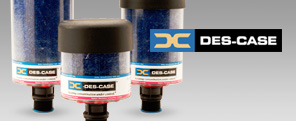 |
|||||||
|
Contamination of the circulating fluid is arguably the most common cause of excess equipment wear and failure in a hydraulic system. Once contamination occurs, and especially if it continues unchecked, the cost of running the equipment, and the risk of its failure both rise, while operating efficiency and reliability both go down. Contaminated fluids can cause serious leakage, low fluid levels and premature component failure. There are numerous potential causes of contamination, but regarding the use of breather filters we are only concerned with fluid volumetric fluctuations and the pressure differentials that accompany them. For fluid systems, internal changes in pressure may require an element to intake or expel air to equalize pressure fluctuations. The most common reason for internal pressure fluctuations is the change in temperature and the resultant expansion and contraction of the fluid. When warm, the fluid expands and the system needs to release pressure (exhale, you might say); when cool, the opposite occurs. All this happens in the name of pressure equalization and always involves an exchange of gas external to the system. Another change in pressure occurs when a system is started up from the off position, and fluid flows from a reservoir and circulates. This usually results in a pressure drop and an intake of air to keep the pressure balanced. Breather Filter Basics A breather filter is installed on reservoirs to suppress expelled oil mist, prevent atmospheric contamination and to permit air movement within the system. The goal is to prevent particles larger than 3 microns (or finer) from passing through the breather element. However, the size of particle targeted for filtering depends on the type of hydraulic system, and this can vary widely. This is not a 'one size fits all situation.' Operating Pressure and Filter Selection During its service life, a breather filter becomes contaminated with particles, oil mist and moisture, so it must be changed periodically. If not, it becomes clogged and ceases "breathing" with the system. This, in turn, can create partial vacuums and pump cavitation within the system. Regular replacement and inspection of breather filters are critical to the long-term performance of hydraulic systems. Acculube fluid management specialists can help solve any issues relative to hydraulic fluids. We have the products and experience to help you make the best possible decisions for your operation and budget.
|

|
||||||
|
|||||||
|
|||||||
Accurate Lubricants & Metalworking Fluids, Inc.• 403 Homestead Avenue; Dayton, Ohio 45417 USA • Phone: 937-461-9906 Fax: 937-461-9917
|
|||||||
